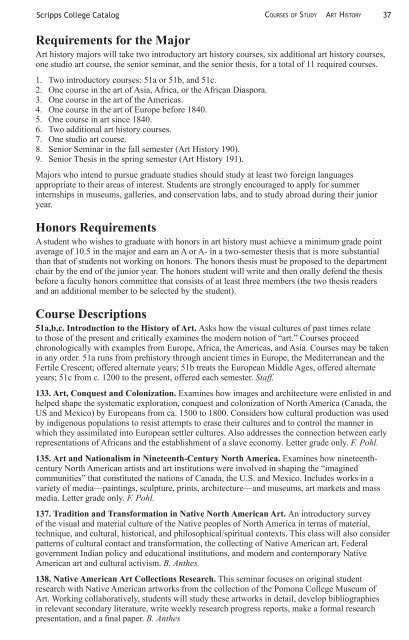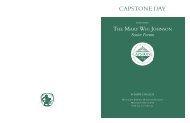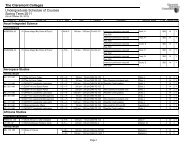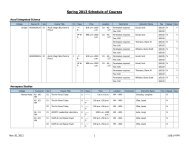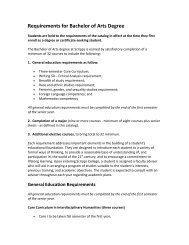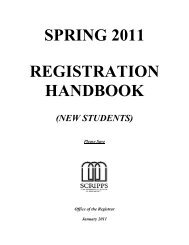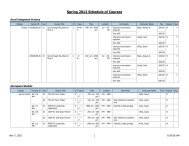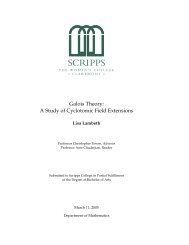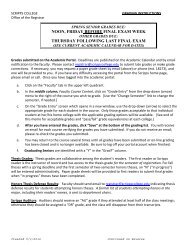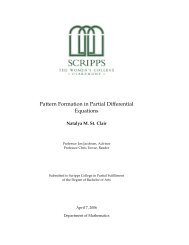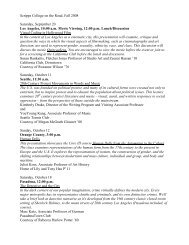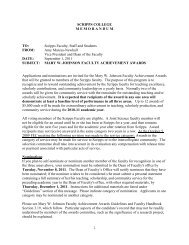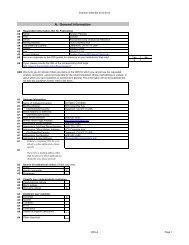PDF of the 2012-2013 Academic Catalog - Scripps College
PDF of the 2012-2013 Academic Catalog - Scripps College
PDF of the 2012-2013 Academic Catalog - Scripps College
You also want an ePaper? Increase the reach of your titles
YUMPU automatically turns print PDFs into web optimized ePapers that Google loves.
<strong>Scripps</strong> <strong>College</strong> <strong>Catalog</strong><br />
Courses <strong>of</strong> Study<br />
Art History<br />
37<br />
Requirements for <strong>the</strong> Major<br />
Art history majors will take two introductory art history courses, six additional art history courses,<br />
one studio art course, <strong>the</strong> senior seminar, and <strong>the</strong> senior <strong>the</strong>sis, for a total <strong>of</strong> 11 required courses.<br />
1. Two introductory courses: 51a or 51b, and 51c.<br />
2. One course in <strong>the</strong> art <strong>of</strong> Asia, Africa, or <strong>the</strong> African Diaspora.<br />
3. One course in <strong>the</strong> art <strong>of</strong> <strong>the</strong> Americas.<br />
4. One course in <strong>the</strong> art <strong>of</strong> Europe before 1840.<br />
5. One course in art since 1840.<br />
6. Two additional art history courses.<br />
7. One studio art course.<br />
8. Senior Seminar in <strong>the</strong> fall semester (Art History 190).<br />
9. Senior Thesis in <strong>the</strong> spring semester (Art History 191).<br />
Majors who intend to pursue graduate studies should study at least two foreign languages<br />
appropriate to <strong>the</strong>ir areas <strong>of</strong> interest. Students are strongly encouraged to apply for summer<br />
internships in museums, galleries, and conservation labs, and to study abroad during <strong>the</strong>ir junior<br />
year.<br />
Honors Requirements<br />
A student who wishes to graduate with honors in art history must achieve a minimum grade point<br />
average <strong>of</strong> 10.5 in <strong>the</strong> major and earn an A or A- in a two-semester <strong>the</strong>sis that is more substantial<br />
than that <strong>of</strong> students not working on honors. The honors <strong>the</strong>sis must be proposed to <strong>the</strong> department<br />
chair by <strong>the</strong> end <strong>of</strong> <strong>the</strong> junior year. The honors student will write and <strong>the</strong>n orally defend <strong>the</strong> <strong>the</strong>sis<br />
before a faculty honors committee that consists <strong>of</strong> at least three members (<strong>the</strong> two <strong>the</strong>sis readers<br />
and an additional member to be selected by <strong>the</strong> student).<br />
Course Descriptions<br />
51a,b,c. Introduction to <strong>the</strong> History <strong>of</strong> Art. Asks how <strong>the</strong> visual cultures <strong>of</strong> past times relate<br />
to those <strong>of</strong> <strong>the</strong> present and critically examines <strong>the</strong> modern notion <strong>of</strong> “art.” Courses proceed<br />
chronologically with examples from Europe, Africa, <strong>the</strong> Americas, and Asia. Courses may be taken<br />
in any order. 51a runs from prehistory through ancient times in Europe, <strong>the</strong> Mediterranean and <strong>the</strong><br />
Fertile Crescent; <strong>of</strong>fered alternate years; 51b treats <strong>the</strong> European Middle Ages, <strong>of</strong>fered alternate<br />
years; 51c from c. 1200 to <strong>the</strong> present, <strong>of</strong>fered each semester. Staff.<br />
133. Art, Conquest and Colonization. Examines how images and architecture were enlisted in and<br />
helped shape <strong>the</strong> systematic exploration, conquest and colonization <strong>of</strong> North America (Canada, <strong>the</strong><br />
US and Mexico) by Europeans from ca. 1500 to 1800. Considers how cultural production was used<br />
by indigenous populations to resist attempts to erase <strong>the</strong>ir cultures and to control <strong>the</strong> manner in<br />
which <strong>the</strong>y assimilated into European settler cultures. Also addresses <strong>the</strong> connection between early<br />
representations <strong>of</strong> Africans and <strong>the</strong> establishment <strong>of</strong> a slave economy. Letter grade only. F. Pohl.<br />
135. Art and Nationalism in Nineteenth-Century North America. Examines how nineteenthcentury<br />
North American artists and art institutions were involved in shaping <strong>the</strong> “imagined<br />
communities” that constituted <strong>the</strong> nations <strong>of</strong> Canada, <strong>the</strong> U.S. and Mexico. Includes works in a<br />
variety <strong>of</strong> media—paintings, sculpture, prints, architecture—and museums, art markets and mass<br />
media. Letter grade only. F. Pohl.<br />
137. Tradition and Transformation in Native North American Art. An introductory survey<br />
<strong>of</strong> <strong>the</strong> visual and material culture <strong>of</strong> <strong>the</strong> Native peoples <strong>of</strong> North America in terms <strong>of</strong> material,<br />
technique, and cultural, historical, and philosophical/spiritual contexts. This class will also consider<br />
patterns <strong>of</strong> cultural contact and transformation, <strong>the</strong> collecting <strong>of</strong> Native American art, Federal<br />
government Indian policy and educational institutions, and modern and contemporary Native<br />
American art and cultural activism. B. An<strong>the</strong>s.<br />
138. Native American Art Collections Research. This seminar focuses on original student<br />
research with Native American artworks from <strong>the</strong> collection <strong>of</strong> <strong>the</strong> Pomona <strong>College</strong> Museum <strong>of</strong><br />
Art. Working collaboratively, students will study <strong>the</strong>se artworks in detail, develop bibliographies<br />
in relevant secondary literature, write weekly research progress reports, make a formal research<br />
presentation, and a final paper. B. An<strong>the</strong>s


